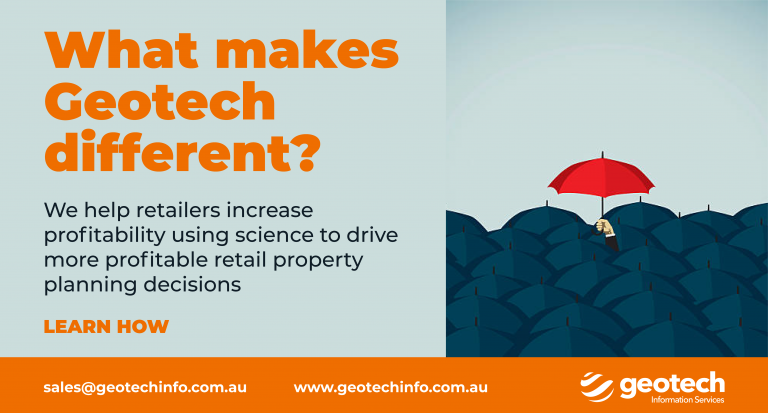I often get asked when out socially what I do for work….. It’s not an easy question to answer. If I was to put into words what Geotech does specifically, I would say that “we help retailers increase profitability by using science to drive more profitable retail property planning decisions.” I don’t think there’s a better way to answer the question more succinctly.
At Geotech, we fill a gap in the market between the skills and experience of the business team including (senior management, property, marketing & operations), and leasing agents that have property available to lease.
So how do we do it?
There are certain factors that drive store success and ultimately profitability. The first thing we explain to prospective clients is that the most important factor is to make sure the locations you choose to open are based firstly on top line revenue then profitability. No amount of landlord assistance or cost cutting is going to make a store opened in the wrong location a top performer. At best you’ll be lucky if it breaks even.
If basing location planning decisions mainly around demographics (which is quite common), then at best you’re probably getting 30% of the picture. Take the example below from a recent market analysis we undertook for a major apparel brand. Residential demographics only accounted for 21% of overall sales performance for each of their stores.
The single biggest predictor of sales was actually the generator activity within the retail precinct and position, accounting for almost 60% of sales performance. Demographics is only slightly more important than store size and competition is least important.

This also highlights that store success for them is much more about feeding off foot traffic and impulse trade and not shoppers who make a conscious decision to visit the store from either home or work.
Conversely, if the brand was highly destinational, demographics would play a much larger part in store success, most likely accounting for at least 30% of sales performance.
What does this tell you?
It’s critically important to know how destinational or impulse driven the brand is. Why pay extra leasing costs if consumers are going to seek you out specifically, therefore you don’t have to be on the most prominent road or pedestrian ant trail in shopping centres.

The illustration above highlights the factors that impact where a brand might sit on the continuum and what you need to be aware of. One simple way to answer the question of whether my brand is destinational is by asking; would the majority of customers make a conscious decision to shop my brand before leaving home or a place of work?
If you are like most brands there will be a proportion of consumers who seek out the brand regardless of location, and a proportion who visit whilst out and about as part of a general shopping outing. Most brands we work with have an element of both but generally rely on some level of passing vehicle or foot traffic to be successful.
We often get asked about catchment area identification and mapping. Catchment areas are defined by where a majority of customers come from to visit a store. There are two ways to define a catchment area;
- Access to customer loyalty or postcode data (at a minimum)
Some brands in specific industries (fashion/accessories/big box/health) capture a lot of data but often don’t know how best to use it. Just by capturing a postcode much can be gained from analysing this small piece of information including mapping out the home addresses of your customers and building a catchment area showing how far they travel to visit the store. - Using mobile device data tracking (to capture customer information)
Other industries, such as fast casual food, don’t capture a lot of data and therefore often don’t know where customers are travelling from or going to after visiting the store. Often these types of purchases are impulse driven and, given convenience is the name of the game, the address of the customer is not captured.
You can gain a lot of insight from using mobile device data tracking to profile the customer journey, whether they visited from home, or work, or were transient and just passing through. Many in the industry do not fully understand the benefits this type of technology & insights bring to network planning.
What makes us different?
Geotech takes a holistic approach in identifying the critical factors that drive store sales performance. This is achieved by using a combination of our unique partner data sources i.e. (Mastercard merchant activity and mobile device data), experience and modelling techniques to identify and quantify the contribution different factors make to sales performance over and above demographics, operations and other intangibles.
Interested in taking the plunge to find out how your business can capitalise on data sets for expansion and growth? Contact Global Business Development Manager, Jeff Vassel, at [email protected].

